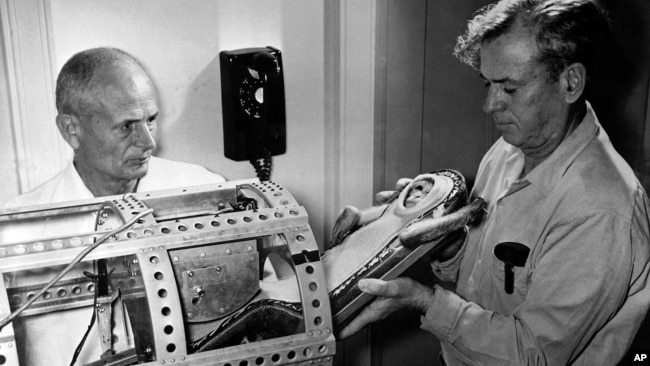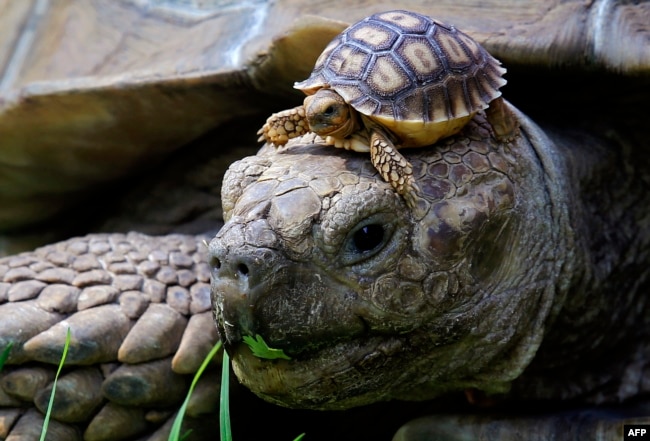宇宙に散った動物宇宙飛行士に黙祷!!!
宇宙への飽くなき挑戦、その陰に多くの動物たちの犠牲による貢献がありました。
今日のVOAは、彼らのお話しです。
黙祷し、哀悼を込めながら。。。
聴きましょう。学びましょう。
動物宇宙飛行士
Animal Astronauts
January 13, 2021
 このNASAの写真は、テキサス大学のヒュー・ブロジェット博士(左)とリン・ブラウン博士が、飛行前のテスト中にサルを容器に入れているところです。実際の打ち上げは1959年12月4日、バージニア州ウォロップス島で行われた。(AP Photo/NASA)
このNASAの写真は、テキサス大学のヒュー・ブロジェット博士(左)とリン・ブラウン博士が、飛行前のテスト中にサルを容器に入れているところです。実際の打ち上げは1959年12月4日、バージニア州ウォロップス島で行われた。(AP Photo/NASA)
人類初の月面着陸は50年以上前に起こりました。しかし、人間の宇宙飛行士が宇宙を旅して月を一周した最初の地球人ではなかったことを知っていましたか?
その栄誉は、2匹のロシア産の亀と、それに同行した数匹の小さな生き物に与えられました。
宇宙空間のカメ
1968年9月14日、ソビエトの宇宙開発計画は、2匹の亀をハエやミミズと一緒に月周回の旅のために宇宙に送りました。NASAはこれを"いかなる国においても、初めて成功した月周回ミッション”と呼んでいます。
一週間の旅の後、カメたちはインド洋のパラシュートで地球に着陸し、10月7日にモスクワに戻りました。
両方の亀は生き残りましたが、実験では生き残っていません。NASAの記録によると、1968年10月11日、宇宙旅行の影響を調べるために、動物を解剖されたとあります。
解剖の結果、"亀の主な構造変化は、食糧不足ではなく、宇宙旅行によって引き起こされた "ことが判明しまいた。亀の体重は10%ほど減っていましたが、活動的な状態を維持していました。しかし、彼らは活動的なままで、食欲の損失を示していませんでした。
地球上の対照群のカメと比較すると、宇宙旅行中のカメは、宇宙飛行に関連した萎縮がわずかに見られました。体の一部が萎縮すると、サイズが小さくなったり、痩せ細ります。
この実験では、この動物が月周回旅行をして生き延びることができることが実証された。しかし、これは人間が同じことができるということを意味するものではありませんでした。その可能性には、より多くの実験が必要でした。
他の動物宇宙旅行者
月周回旅行をしたのはカメが初めてですが、他の動物たちも、人類の宇宙理解と探査に貢献してきました。NASAのウェブサイトでは、宇宙での動物の歴史について説明しています。
1948年、アメリカはV-2ブロッサムと呼ばれる宇宙船に乗ってアカゲザルを宇宙に打ち上げ始めました。サルのアルバート1世は6月11日に打ち上げられました。1949年6月14日、別のV-2の飛行で、アルバート2世は約133キロの高さに達しました。アルバート2世は再突入時の衝撃で死亡しました。
最後のV-2飛行は1949年12月12日でした。これには猿のアルバート4世が搭乗していました。NASAのウェブサイトでは ”サルの飛行は成功し、衝突して死亡するまでは 何の影響もなかった ”としています。
宇宙空間の犬

打ち上げ前のスプートニクII宇宙カプセルに搭乗したメス犬のライカ。(APファイル写真)
アメリカがたくさんのサルを使って実験をしていたのに対し、ソ連はたくさんの犬を使って実験をしていました。
1957年11月3日、ソ連はライカという犬を乗せてスプートニク2号を地球の軌道に打ち上げました。NASAの科学者によると、ライカは数時間後に死亡したといいます。スプートニク2は5ヶ月間軌道に乗り続け、1958年4月に大気圏外で燃え尽きました。
そしてその年の12月13日、アメリカは木星ロケットで約965キロの高さにゴルドというリスザルを打ち上げました。科学者たちは彼の体の機能を観察することができました。
ゴルドのカプセルは大西洋で発見されることはありませんでした。浮遊装置が故障して水しぶきを浴びて死にました。しかし、科学者たちは、彼の呼吸と心拍を測定した結果、人間が同じような旅をしても生き残れることを証明したと述べています。
これらは、動物が人間の宇宙探査に貢献してきたほんの一例に過ぎません。マウスや猫もまた、地球を越えた旅が生物にどのような影響を与えるかを科学者が理解するのに役立っていることを忘れてはなりません。
*****************************
黙祷!!
A Brief History of Animal in Space
「過去50年以上にわたり、アメリカとソ連の科学者たちは動物を実験に利用してきました。犠牲者が出たにもかかわらず、これらの動物たちは、動物なしでは学べなかったであろう膨大な量のことを科学者たちに教えてくれました。有人宇宙開発計画の初期に動物実験を行っていなければ、ソ連とアメリカの計画は人間の命を大きく失うことになっていたかもしれません。これらの動物たちは、人間にはできない、あるいはできなかったであろう、それぞれの国への奉仕をしてくれました。動物たちは、技術の進歩の名の下に、自分たちの命や奉仕を捧げ、人類の多くの宇宙進出への道を切り開いたのです。」と記されています。
VOAに乗っていない動物たちも紹介されています。
「1951年9月20日、ニューメキシコ州のホロマン空軍基地で236,000フィートで飛行したアエロビーミサイルの後、ヨリックという名のサルと11匹のマウスが回収されました。
1952年5月22日、2匹のフィリピン猿、パトリシアとマイク。
パトリシアは座位、マイクは伏位の状態にして、急加速の影響の違いを調べました。時速2000マイルで36マイル上空を飛行したこの2匹のサルは、このような高高度に到達した最初の霊長類でした。
パトリシアは約2年後に自然死し、マイクは1967年にワシントンの国立動物園で亡くなりました。」
その他は上記H.P.でどうぞ。
さらに下記リンクStudent Featuresには、研究者たちが、拒否権の動物たちに倫理的人道的ケアをいかにしているかにも触れられています。
Animal Astronauts
 This NASA photo shows Dr. Hugh Blodgett (left) and Dr. Lynn Brown, both of the University of Texas, placing a monkey in a container during a pre-flight test. This actual launch was on December 4, 1959, at Wallops Island, Virginia. (AP Photo/NASA)
This NASA photo shows Dr. Hugh Blodgett (left) and Dr. Lynn Brown, both of the University of Texas, placing a monkey in a container during a pre-flight test. This actual launch was on December 4, 1959, at Wallops Island, Virginia. (AP Photo/NASA)
The first human moon landing happened more than 50 years ago. But did you know that human astronauts were not the first Earthlings to travel in space and circle the moon?
That honor goes to two Russian tortoises and several smaller creatures that went along for the ride.
Tortoises in space
On September 14, 1968, the Soviet space program sent two tortoises -- along with some flies and worms -- into space for a trip around the moon. NASA calls it “the first successful circumlunar mission carried out by any nation.”
After a week-long trip, the tortoises landed on Earth by parachute in the Indian Ocean. They traveled back to Moscow on October 7.
Both tortoises survived the trip but not the experiment. NASA records state that the animals were dissected on October 11, 1968, to see how their bodies were affected by the space travel.
Dissection showed that “the main structural changes in the tortoises were caused by a lack of food and not the space travel.” The tortoises had lost about 10 percent of their body weight. But they had stayed active and showed no loss of appetite.
When compared with a control group of tortoises on Earth, the space traveling creatures had a small amount of spaceflight-related atrophy. When parts of the body atrophy, they decrease in size or waste away.
The experiment demonstrated that the animals could travel around the moon and survive. But this did not mean that humans could do the same. That possibility required more testing.
Other animal space travelers
While tortoises were the first to travel around the moon, other animals have helped humans understand and explore space. On its website, NASA explains its history with animals in space.
In 1948, the U.S. began launching rhesus monkeys into space aboard a spacecraft called the V-2 Blossom. The monkey Albert I went up on June 11. On June 14, 1949, aboard another V-2 flight, Albert II reached a height of about 133 kilometers. Albert II died on impact at re-entry.
The last V-2 flight was on December 12, 1949. It involved the monkey Albert IV. On its website, NASA calls it “a successful flight, with no ill effects on the monkey until impact, when it died.”
Dogs in space
While the United States was experimenting with a lot of monkeys, the Soviet Union was experimenting with a lot of dogs.
On November 3, 1957, the Soviet Union launched Sputnik 2 into Earth’s orbit with a dog named Laika on board. NASA scientists say that Laika died after a few hours. Sputnik 2 continued to orbit for five months and then burned up in the outer atmosphere in April 1958.
Then later that year on December 13, the U.S. launched a squirrel monkey named Gordo about 965 kilometers high in a Jupiter rocket. Scientists were able to observe his body functions.
Gordo's capsule was never found in the Atlantic Ocean. He died on splashdown when a flotation device failed. However, scientists said readings taken of his breathing and heartbeat proved that humans could survive a similar trip.
These are just a few examples of how animals have helped humans explore space. We should not forget that mice and cats have also been used to help scientists better understand how travel beyond Earth affects living things.
_______________________________________________________________
Words in This Story
circumlunar – adj. revolving about or surrounding the moon
dissect – v. to cut (a plant or dead animal) into separate parts in order to study it
appetite – n. a natural desire especially for food
atrophy – v. decrease in size or wasting away of a body part or tissue
impact – n. the act or force of one thing hitting another
ill – adj. not well or healthy : sick or unhealthy
capsule – n. a small part of a spacecraft that is separate from the rest of the spacecraft and that is where people live and work
flotation – n. the act, process, or state of floating or of causing or allowing something to float
